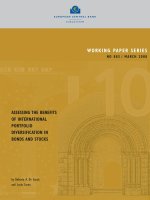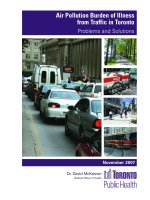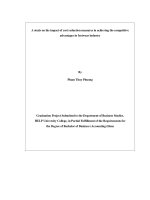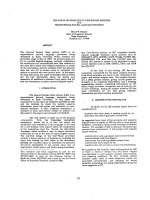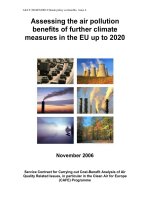Assessing the air pollution benefits of further climate measures in the EU up to 2020 pot
Bạn đang xem bản rút gọn của tài liệu. Xem và tải ngay bản đầy đủ của tài liệu tại đây (345.47 KB, 29 trang )
AEAT/ ED48763001/Climate policy co-benefits. Issue 6
Assessing the air pollution
benefits of further climate
measures in the EU up to 2020
November 2006
Service Contract for Carrying out Cost-Benefit Analysis of Air
Quality Related Issues, in particular in the Clean Air for Europe
(CAFE) Programme
AEAT/ ED48763001/Climate policy co-benefits. Issue 6
Title Assessing the air pollution benefits of further climate
measures in the EU up to 2020 for
Service Contract for carrying out cost-benefit analysis of air
quality related issues, in particular in the clean air for Europe
(CAFE) programme
Customer
European Commission DG Environment
Customer reference
ENV.C.1/SER/2003/0027
Confidentiality,
copyright and
reproduction
This document has been prepared by AEA Technology plc in
connection with a contract to supply goods and/or services and
is submitted only on the basis of strict confidentiality. The
contents must not be disclosed to third parties other than in
accordance with the terms of the contract.
Validity
Issue 6
File reference
Reference number
AEAT/ ED48763001/ Climate policy co-benefits
AEA Technology Environment
The Gemini Building, Fermi Avenue
Harwell International Business Centre
Didcot, OX11 0QR, United Kingdom
Telephone +44 (0) 870 190 6554
Facsimile +44 (0) 870 190 6318
Email:
AEA Technology Environment is a business division of
AEA Technology plc
AEA Technology Environment is certificated to ISO9001 & ISO 14001
Name Signature Date
Authors
Mike Holland (EMRC)
Steve Pye (AEA Technology)
08/11/06
Reviewed by
Steve Pye
Approved by
Steve Pye
AEAT/ ED48763001/Climate policy co-benefits. Issue 6
i
Executive Summary
Action to reduce CO
2
emissions has the potential to also reduce emissions of various regional
air pollutants, such as SO
2
, NOx and fine particles. This can arise, for example, as a result of
fuel switching or through the implementation of various energy efficiency measures.
This report assesses the co-benefits of climate policy scenarios via changes in emissions of
NH
3
, NOx, PM
2.5
, SO
2
and VOCs to get an understanding of the magnitude of these benefits.
Three levels of climate policy are considered using the CAFE methodology against scenarios
for the year 2020:
•
Carbon price of €0;
• Carbon price of €20 and
• Carbon price of €90.
All three scenarios describe emissions assuming that current legislation (CLE, the baseline for
the CAFE assessments) for air pollutants is in place. As a sensitivity these three carbon price
scenarios were combined with the Maximum Feasible Reduction case (MFR) for air
pollutants according to the RAINS model at price levels of €20 and €90/t CO
2
.
For the Current Legislation Scenario, moving from a shadow carbon price of €0/t CO
2
to
€20/t CO
2
leads to a fall in emissions of 390 million tonnes for CO
2
, 277 thousand tonnes (kt)
for NOx, 43 kt for PM
2.5
and 397 kt for SO
2
by 2020. Increasing the price from €20/t CO
2
to
€90/t CO
2
would lead to a further increase of 563 million tonnes for CO
2
, 460 thousand
tonnes (kt) for NOx, 38 kt for PM
2.5
and 418 kt for SO
2
by 2020. An increase in price from
€0/t CO
2
to €90/t CO
2
would thus lead to a total fall in emissions of 953 million tonnes for
CO
2
, 737 thousand tonnes (kt) for NOx, 81 kt for PM
2.5
and 815 kt for SO
2
by 2020.
The following figure summarises these results in terms of the % change in emissions of each
pollutant across the EU25 relative to a price of €0/t CO
2
t in 2020 under the Current
Legislation Scenario.
AEAT/ ED48763001/Climate policy co-benefits. Issue 6
ii
70
75
80
85
90
95
100
105
€0/t CO2 €20/t CO2 €90/t CO2
CO2
SO2
NOx
PM2.5
Estimated % reduction (in 2020 under CLE scenario) in emissions of CO
2
, NOx, PM
2.5
and SO
2
in 2020 in response to increasing levels of climate policy. Emissions of NH
3
and
VOCs are little affected by climate policy.
The PRIMES model, run at the National Technical University of Athens (NTUA), was used
to estimate the effect of CO
2
prices on energy consumption and fuel use in Europe. The
outputs from PRIMES were used by the RAINS model to forecast emissions of NH
3
, NOx,
PM
2.5
, SO
2
and VOCs for each country in the EU25 for baseline conditions under current
legislation (CLE) for 2020 with shadow carbon prices of €0, €20 and €90/t CO
2
, and also for
scenarios describing the maximum feasible reduction (MFR). These emission estimates fed
into the EMEP Eulerian model, which models the associated changes in air pollution
concentrations.
The changes in concentration levels (relative to the baseline) were then input into the CAFE
cost-benefits model; using concentration-response functions, the health impacts were
estimated. The CBA analysis enables a link between changes in NOx, PM
2.5
and SO
2
and
various health impacts including mortality, the incidence of bronchitis, hospital admissions
for respiratory and cardiac illness and various other effects such as restrictions to daily
activity and increased incidence of asthma symptoms. Quantified impacts are monetised
using values agreed with stakeholders during the CAFE programme. Results are shown in the
figure below. The low-high ranges reflect sensitivity to the approach used to characterise
mortality impacts.
AEAT/ ED48763001/Climate policy co-benefits. Issue 6
iii
8.5
6.2
14.7
27.8
20.4
48.1
0
10
20
30
40
50
60
€0 to €20/t CO2 €20 to €90/t CO2 €0 to €90/t CO2
Health benefits, €billion/year
Low
High
Annual co-benefits (€ billions) for climate policy under the CLE scenario in terms of the
change in health impacts as a result of reduced emissions of NOx, PM
2.5
and SO
2
in 2020
for the EU-25.
1
Results indicate that climate policy is likely to generate ancillary benefits through reductions
in regional air pollutants of several €billion each year. The analysis indicate that the co-
benefits can be significant and vary between nearly 10 to just under 50 billion € per year
depending on how vigorous a climate policy is pursued.
The analysis does not include all impacts of NOx, PM and SO
2
, perhaps most significantly the
effects of SO
2
and NOx on ecosystems but also impacts on materials and crops are also
missing. This clearly biases the results to underestimation of benefits.
1
Co-benefits under the Maximum Feasible Reduction Scenario according to the RAINS model are smaller as
there is significantly less emission of NOx, etc., at the starting point.
AEAT/ ED48763001/Climate policy co-benefits. Issue 6
iv
Contents
THE CO-BENEFITS OF CLIMATE POLICY 1
I
NTRODUCTION
1
S
CENARIOS INVESTIGATED
1
M
ETHODS
2
R
ESULTS
2
D
ISCUSSION
11
REFERENCES 13
APPENDIX 1 CO-BENEFITS OF CLIMATE POLICY UNDER MAXIMUM
FEASIBLE REDUCTION (MFR) SCENARIO 14
APPENDIX 2 EMISSIONS FOR THE CLIMATE POLICY ANALYSIS. 17
AEAT/ ED48763001/Climate policy co-benefits. Issue 6
v
AEAT/ ED48763001/Climate policy co-benefits. Issue 6
1
The co-benefits of climate policy
Introduction
Action to reduce CO
2
emissions has the potential to also reduce emissions of various regional
air pollutants, such as SO
2
, NOx and fine particles. This can arise, for example, as a result of
fuel switching or through the implementation of various energy efficiency measures.
Past analysis of the benefits of abating the CAFE pollutants (NH
3
, NOx, PM
2.5
, SO
2
and
VOCs) has started from a baseline scenario where CO
2
emissions are stabilised by 2020, with
an estimated shadow price for CO
2
control of €20/t. The question then naturally arises of
what additional benefits via further reductions in the CAFE pollutants could accrue from
different levels of climate policy.
Scenarios investigated
As part of the CAFE work, a set of emission scenarios were developed based around three
different prices for CO
2
, €0/t (IIASA, 2005), €20/t and €90/t (IIASA, 2004). The PRIMES
model, run at the National Technical University of Athens (NTUA), was used to estimate the
effect of these prices on energy consumption and fuel use in Europe. For this analysis
PRIMES implicitly assumed that the overall economy did not change (i.e. Europe produces
the same amount of cement, steel, etc. in each model run) with exactly the same GDP growth
between 2000 and 2020. This would of course not be the case if it was known that CO
2
would cost €90/t. The European economy would be likely to move towards different
production modes, producing less energy intensive goods. One effect of this is that the model
runs presented here are likely to provide an underestimate of ancillary benefits in Europe via
reductions in emissions of the CAFE pollutants. A general equilibrium analysis should
ideally be performed to characterise these broader impacts on the economy.
The outputs from PRIMES were used by the RAINS model to forecast emissions of NH
3
,
NOx, PM
2.5
, SO
2
and VOCs for each country in the EU25 for baseline conditions under
current legislation (CLE) for 2020 with shadow carbon prices of €0, €20 and €90/t CO
2
, and
also for scenarios describing the maximum feasible reduction (MFR) in each pollutant
according to the measures included in RAINS for shadow carbon prices of €20 and €90/t CO
2
.
The results associated with the MFR scenario are shown in Appendix 1. Total emissions are
shown in Table 1 and the change in emissions with increasing carbon price is shown in Table
2. National emissions of each pollutant are given in Appendix 2.
Table 1. Total emissions (kt) in 2020 under the scenarios investigated.
Pollutant CLE, €0/t CO
2
CLE, €20/t CO
2
CLE, €90/t CO
2
NH
3
3,687 3,687 3,677
NOx 12,114 11,837 11,377
PM
2.5
1,364 1,321 1,283
SO
2
6,729 6,332 5,914
VOCs 6,135 6,139 6,107
AEAT/ ED48763001/Climate policy co-benefits. Issue 6
2
Table 2. Change in emissions (kt) in 2020 with increased CO
2
price.
Pollutant CLE, €0 to €20/t
CO
2
CLE, €20 to
€90/t CO
2
CLE, €0 to €90/t
CO
2
NH
3
0 10 10
NOx 277 460 737
PM
2.5
43 38 81
SO
2
397 418 815
VOCs -4 (increase)
32 28
Methods
The emissions data derived by RAINS for each scenario were used in the EMEP model to
estimate the concentration and deposition of air pollutants across Europe on a 50 x 50 km
grid. The analysis presented here then applied the CAFE methodology (Holland et al, 2005a,
b; Hurley et al, 2005) to the EMEP outputs to quantify the health impacts arising from
emissions of each pollutant, mediated through exposure to primary and secondary particles.
Effects on both mortality and morbidity were quantified. Sensitivity analysis on mortality
characterisation and valuation provides a range of estimates, as follows:
• CAFE-low: Quantifies mortality as years of life lost (YOLL) and applies the median
estimate of the value of a life year (VOLY)
2
.
•
CAFE-low/mid: Quantifies mortality as deaths and applies the median estimate of the
value of a statistical life (VSL).
•
CAFE-high/mid: Quantifies mortality as YOLL and values it using the mean estimate
of the VOLY.
• CAFE-high: Quantifies mortality in terms of deaths and values it using the mean
estimate of the VSL.
The analysis presented here did not include quantification of various other impacts associated
with emissions of NOx, PM and SO
2
. The most significant omissions are likely to be:
1. Effects of acidification and eutrophication following emission of nitrogen and sulphur on
ecosystems.
2. Effects of ozone on health, crops and ecosystems linked to emissions of NOx and VOCs.
Following from the CAFE analysis it is very likely that these effects are small compared
to the health impacts of exposure to PM. Note that effects on health and crops from ozone
are usually included in the CAFE analysis.
3. Damage to materials.
Results
Estimates of health impacts from exposure to primary and secondary particles are shown in
Table 3. Health impacts are subsequently shown in monetary equivalent in the following
tables. Total estimates of annual damage are given in Table 4. Incremental benefits arising
from the changes in CO
2
price are shown in Table 5. Results at the national level are shown
in Table 6 to Table 9 for the CAFE-low and CAFE-high assumptions. Results have been
2
More complete discussion of mortality valuation is given in Volume 2 of the CAFE-CBA methodology report
(Hurley et al, 2005), and in the CAFE-CBA scenario analyses (Holland et al, 2005d, e).
AEAT/ ED48763001/Climate policy co-benefits. Issue 6
3
checked against a simplified method, using marginal damage estimates generated using the
CAFE methods, and good agreement has been found (Holland and Pye, 2006).
Table 3. Estimated annual health impacts in 2020 (EU25) via population exposure to
primary and secondary particles under current legislation (CLE) scenario based on
different prices applied to CO
2
(thousands).
Health endpoint €0/t CO
2
€20/t CO
2
€90/t CO
2
Chronic Mortality – thousand years of life lost
(YOLLS)
1
2,484
2,369
2,285
Chronic Mortality – thousand deaths
1
265
252
243
Infant Mortality (0-1yr) – thousand deaths 0.34
0.33
0.32
Chronic Bronchitis (thousand cases, adults) 125
119
115
Respiratory Hospital Admissions (thousands) 41
39
38
Cardiac Hospital Admissions (thousands) 25
24
23
Restricted Activity Days (thousands) 216,631
206,661
199,323
Respiratory medication use (thousand days,
children)
1,956
1,872
1,815
Respiratory medication use (thousand days,
adults)
20,359
19,409
18,708
Lower respiratory symptom days (thousands,
children)
87,109
83,199
80,477
Lower respiratory symptom days (thousands,
adults)
202,518
193,111
186,213
1
For chronic mortality (PM), two alternative values are presented, based on quantification using years of life lost
and numbers of premature deaths). The two measures are not additive.
Table 4. Estimated annual damage in 2020 (EU25) via population exposure to primary
and secondary particles under current legislation (CLE) scenario based on different
prices applied to CO
2
.
Sensitivity case €0/t (€M) €20/t (€M) €90/t (€M)
CAFE-low 183,084 174,606 168,410
CAFE-low/mid 312,573 297,824 286,996
CAFE-high/mid 345,197 329,219 317,556
CAFE-high 587,298 559,544 539,170
Table 5. Incremental benefits in 2020 with increasing price of CO
2
under the CLE
scenario.
Sensitivity case €0 - 20/t (€M) €20 - 90/t (€M) €0 - 90/t (€M)
CAFE-low
8,479
6,196 14,674
CAFE-low/mid
14,749
10,828 25,577
CAFE-high/mid
15,979
11,663 27,641
CAFE-high
27,754
20,374 48,128
AEAT/ ED48763001/Climate policy co-benefits. Issue 6
4
Table 6. Estimated annual damage (€millions) in 2020 by country for each CO
2
price
scenario using the CAFE-low assumptions (under the CLE scenario).
Country €0/t CO
2
€20/t CO
2
€90/t CO
2
Austria 2,790
2,609
2,451
Belgium 7,408
7,154
6,914
Cyprus 267
218
220
Czech Republic 4,134
3,701
3,377
Denmark 1,850
1,793
1,785
Estonia 227
229
235
Finland 770
767
800
France 25,871
24,534
23,988
Germany 40,359
37,782
35,815
Greece 3,958
3,576
3,506
Hungary 4,406
4,128
3,845
Ireland 948
956
980
Italy 21,437
20,521
19,809
Latvia 450
440
440
Lithuania 965
938
916
Luxembourg 281
260
247
Malta 198
191
191
Netherlands 11,233
10,965
10,696
Poland 16,900
15,789
14,430
Portugal 2,222
2,185
2,205
Slovakia 2,322
2,108
1,925
Slovenia 748
707
668
Spain 8,827
8,664
8,510
Sweden 1,886
1,826
1,841
UK 22,627
22,566
22,615
Total 183,084
174,606
168,410
AEAT/ ED48763001/Climate policy co-benefits. Issue 6
5
Table 7. Estimated annual damage (€millions) in 2020 by country for each CO
2
price
scenario using the CAFE-high assumptions (under the CLE scenario).
Country €0/t CO
2
€20/t CO
2
€90/t CO
2
Austria 8,649
8,086
7,598
Belgium 23,016
22,224
21,481
Cyprus 647
527
534
Czech Republic 13,544
12,124
11,062
Denmark 6,206
6,013
5,987
Estonia 825
834
856
Finland 2,444
2,437
2,540
France 75,596
71,689
70,093
Germany 137,183
128,422
121,737
Greece 14,420
13,029
12,773
Hungary 16,144
15,127
14,088
Ireland 2,398
2,418
2,478
Italy 79,012
75,635
73,012
Latvia 1,166
1,139
1,139
Lithuania 4,535
4,411
4,309
Luxembourg 664
614
584
Malta 580
560
559
Netherlands 33,306
32,511
31,714
Poland 52,065
48,643
44,455
Portugal 7,501
7,377
7,442
Slovakia 6,982
6,338
5,790
Slovenia 2,497
2,361
2,230
Spain 28,902
28,369
27,867
Sweden 5,923
5,734
5,781
UK 63,095
62,925
63,062
Total 587,298
559,544
539,170
AEAT/ ED48763001/Climate policy co-benefits. Issue 6
6
Table 8. Estimated incremental benefits in 2020 by country between scenarios of
increasing CO
2
price (€millions) using the CAFE-low assumptions (under the CLE
scenario).
Country €0 to 20/t CO
2
€20 to 90/t CO
2
€0 to 90/t CO
2
Austria
181
158
339
Belgium
254
240
494
Cyprus
49
-2
47
Czech Republic
433
324
757
Denmark
57
8
65
Estonia
-2
-6
-8
Finland
3
-33
-30
France
1,337
546
1,883
Germany
2,577
1,967
4,544
Greece
382
70
452
Hungary
278
283
561
Ireland
-8
-24
-32
Italy
916
712
1,628
Latvia
10
0
10
Lithuania
27
22
49
Luxembourg
21
13
34
Malta
7
0
7
Netherlands
268
269
537
Poland
1,111
1,359
2,470
Portugal
37
-20
17
Slovakia
214
183
397
Slovenia
41
39
80
Spain
163
154
317
Sweden
60
-15
45
UK
61
-49
12
Total 8,478
6,196
14,674
AEAT/ ED48763001/Climate policy co-benefits. Issue 6
7
Table 9. Estimated incremental benefits in 2020 by country between scenarios of
increasing CO
2
price (€millions) using the CAFE-high assumptions (under the CLE
scenario).
Country €0 to 20/t CO
2
€20 to 90/t CO
2
€0 to 90/t CO
2
Austria 563
488
1,051
Belgium 792
743
1,535
Cyprus 120
-7
113
Czech Republic 1,420
1,062
2,482
Denmark 193
26
219
Estonia -9
-22
-31
Finland 7
-103
-96
France 3,907
1,596
5,503
Germany 8,761
6,685
15,446
Greece 1,391
256
1,647
Hungary 1,017
1,039
2,056
Ireland -20
-60
-80
Italy 3,377
2,623
6,000
Latvia 27
0
27
Lithuania 124
102
226
Luxembourg 50
30
80
Malta 20
1
21
Netherlands 795
797
1,592
Poland 3,422
4,188
7,610
Portugal 124
-65
59
Slovakia 644
548
1,192
Slovenia 136
131
267
Spain 533
502
1,035
Sweden 189
-47
142
UK 170
-137
33
Total 27,754
20,374
48,128
Although overall it is found that benefits arise as carbon price increases, results for a number
of countries in Table 8 and Table 9 show an increase in damage as CO
2
price increases, even
though they generally have a reduction in emissions. Table 10 expresses these changes as a
% of total damage for each country, whilst Table 11 and Table 12 show the changes in
emissions of SO
2
and NOx between scenarios for each country, with those giving negative
incremental damage (highlighted) tending to have relatively small reductions in emissions
between scenarios. These results are further discussed in the conclusions, below.
AEAT/ ED48763001/Climate policy co-benefits. Issue 6
8
Table 10. % change in health damage from PM
2.5
exposure between scenarios.
Countries with a negative effect (increased damage) are highlighted (under the CLE
scenario).
Country €0 to 20/t CO
2
€20 to 90/t CO
2
€0 to 90/t CO
2
Austria 7%
6%
12%
Belgium 3%
3%
7%
Cyprus 19%
-1%
17%
Czech Republic 10%
8%
18%
Denmark 3%
0%
4%
Estonia -1%
-3%
-4%
Finland 0%
-4%
-4%
France 5%
2%
7%
Germany 6%
5%
11%
Greece 10%
2%
11%
Hungary 6%
6%
13%
Ireland -1%
-3%
-3%
Italy 4%
3%
8%
Latvia 2%
0%
2%
Lithuania 3%
2%
5%
Luxembourg 8%
5%
12%
Malta 3%
0%
4%
Netherlands 2%
2%
5%
Poland 7%
8%
15%
Portugal 2%
-1%
1%
Slovakia 9%
8%
17%
Slovenia 5%
5%
11%
Spain 2%
2%
4%
Sweden 3%
-1%
2%
UK 0%
0%
0%
Total 5%
3%
8%
AEAT/ ED48763001/Climate policy co-benefits. Issue 6
9
Table 11. Reduction in emissions of SO
2
(kt) between CLE scenarios for 2020.
Highlighted cells correspond to the cells with negative incremental damages from Table
8 and Table 9.
Country €0 to 20/t CO
2
€20 to 90/t CO
2
€0 to 90/t CO
2
Austria 2
3
5
Belgium 8
12
20
Cyprus 0
1
1
Czech Rep 10
17
27
Denmark 1
0
1
Estonia 1
3
4
Finland -2
6
4
France 18
23
41
Germany 94
73
167
Greece 3
10
13
Hungary 8
11
19
Ireland 0
1
1
Italy 27
38
65
Latvia 1
0
1
Lithuania 3
3
6
Luxembourg 0
0
0
Malta 1
1
2
Netherlands -2
2
0
Poland 169
169
338
Portugal 6
7
13
Slovakia 5
8
13
Slovenia 3
2
5
Spain 15
20
35
Sweden 10
1
11
UK 16
7
23
EU25 397
418
815
Atlantic Ocean 0
0
0
Baltic Sea 0
0
0
Black Sea 0
0
0
Mediterranean 0
0
0
North Sea 0
0
0
Sea regions 0
0
0
Total 397
418
815
SO
2
changes in the country/scenario combinations with negative damage tend to be small (a
maximum of 7 kt/year, for Portugal and the UK) compared to the other estimates (a maximum
of 338 kt/year for Poland).
AEAT/ ED48763001/Climate policy co-benefits. Issue 6
10
Table 12. Reduction in emissions of NOx (kt) between CLE scenarios for 2020.
Highlighted cells correspond to the cells with negative incremental damages from Table
8 and Table 9.
Country €0 to 20/t CO
2
€20 to 90/t CO
2
€0 to 90/t CO
2
Austria 0
10
10
Belgium 12
17
29
Cyprus 1
1
2
Czech Rep 11
23
34
Denmark 0
4
4
Estonia 1
3
4
Finland -5
7
2
France 28
41
69
Germany 101
55
156
Greece 6
15
21
Hungary 8
7
15
Ireland 2
7
9
Italy 29
41
70
Latvia 2
0
2
Lithuania 2
2
4
Luxembourg 0
2
2
Malta 0
1
1
Netherlands 3
13
16
Poland 26
55
81
Portugal 9
15
24
Slovakia -2
7
5
Slovenia 4
2
6
Spain 16
54
70
Sweden 11
7
18
UK 12
71
83
EU25 277
460
737
Atlantic Ocean 0
0
0
Baltic Sea 0
0
0
Black Sea 0
0
0
Mediterranean 0
0
0
North Sea 0
0
0
Sea regions 0
0
0
Total 277
460
737
In general, the country/scenario combinations with negative incremental damage tend to have
small reductions in NOx emissions compared to those seen elsewhere, exceptions being the
UK and to a lesser extent Portugal.
AEAT/ ED48763001/Climate policy co-benefits. Issue 6
11
Discussion
Results indicate that climate policy is likely to generate ancillary benefits through reductions
in regional air pollutants of several €billion each year. To illustrate, the incremental benefit
through reduction in regional air pollutant emissions of moving from CLE €20/t CO
2
to CLE
€90/t CO
2
, is estimated at between €6 and €20 billion. Benefits of moving from CLE €0/t
CO
2
to CLE €90/t CO
2
is estimated between nearly €15 and €48 billion.
Comparing the data in Table 2 with the results of Table 5 shows that the move from €0/t CO
2
to €20/t yields a rather higher benefit than the move from €20/t to €90/t, although the
emission reductions for the latter are slightly higher (with the exception of PM
2.5
). There are
likely to be two reasons for this:
1. Non-linearities in some atmospheric processes as emission levels change.
2. Differences in the location of emission reductions. Given that these results are
entirely health-driven, emissions in areas with a high regional population density
(i.e. central parts of Europe, including countries such as the Czech Republic,
Germany and France) will generate higher damage than emissions at the edges of
Europe (e.g. in countries like Latvia, Greece or Portugal).
The benefits calculated here for moving to a higher CO
2
price are lower for the MFR scenario
(see results in Appendix 1) than for the CLE scenario. In large part this is due to the MFR
€20/t scenario starting at a lower level of NOx, PM
2.5
and SO
2
emission than its CLE
counterpart.
Table 10 highlighted negative increments (increased damage) between scenarios of reduced
emissions for some countries. Inspection of the countries concerned reveals that they are all
around the edges of Europe. Six reasons are offered for this behaviour, most linked to
secondary aerosol (sulphate and nitrate) formation as this underpins the health impacts
quantified here.
1. In some cases there are modest increases in emission between successive
scenarios, going against the trend seen in most other countries. This will reflect
particular characteristics of the energy and transport sectors in the countries
concerned (such as shifts from coal to gas to reduce carbon emissions that could
increase NO
x
emissions, or from gas to biomass that could increase PM
emissions).
2. Emissions of SO
2
and NOx from shipping are not affected by the scenarios
considered. The countries affected all border the sea (though some countries that
border the sea, such as Italy and Greece do not behave in this way). On its own
this would not lead to an increase in secondary aerosols, but provides a rich source
of pollutants available for reaction with ammonia and photo-oxidants.
3. Emissions of NH
3
from agriculture are almost unaffected by the scenarios
investigated. Reduced emissions of SO
2
and NOx in more central areas of Europe
could lead to a larger amount of NH
3
being transported to surrounding countries
and becoming available there for reactions leading to the formation of nitrate and
sulphate aerosols.
4. Emissions of VOCs are similarly little affected. Reduced emissions of NOx in
central parts of Europe could lead to more VOC leaking out to surrounding
countries, raising ozone concentrations there and thus accelerating oxidation of
SO
2
and NOx to sulphate and nitrate.
AEAT/ ED48763001/Climate policy co-benefits. Issue 6
12
5. Non-linearities in ozone-NOx-VOC relations mean that for some countries
(especially Belgium, the Netherlands and the UK, though the precise list of
countries is dependent on which ozone metric is selected) a reduction in NOx
emissions leads to an increase in ozone levels. Again, this would accelerate
oxidation of SO
2
and NOx to sulphate and nitrate.
6. Country/scenario combinations with negative damage tend to be associated with
small reductions in emissions of SO
2
and NOx (noting the apparent exceptions of
the UK particularly, and Spain and Portugal, with respect to NOx).
These results emphasise the need to reduce emissions of:
• SO
2
and NOx from shipping (see point 2 above)
•
NH
3
from agriculture (see point 3 above)
• VOCs from various sources (see points 4 and 5 above)
None of these are affected at all significantly by the scenarios considered. The results also
emphasise the trans-boundary nature of the air pollutants considered under the CAFE
Programme and the need to examine the occasional, counterintuitive small increases in
damage for some countries in detail to reveal the causes (such as a change in energy supply,
atmospheric chemistry). Nevertheless, the incremental benefits through reduction in regional
air pollutant emissions of more demanding climate policies reflected in higher carbon prices
can be significant, ranging from €6-20 billion per year (for a price increase of €20/t CO
2
to
€90/t CO
2
) to nearly €15 and €48 billion (for an increase of €0/t CO
2
to €90/t CO
2
with
current air pollution legislation).
This scenario analysis could be improved by using the PRIMES model to perform a general
equilibrium analysis to describe the overall effects of the change in the shadow price for CO
2
on the structure of the overall economy.
AEAT/ ED48763001/Climate policy co-benefits. Issue 6
13
References
Holland, M., Hunt, A., Hurley, F., Navrud, S., Watkiss, P. (2005a) Methodology for the Cost-
Benefit analysis for CAFE: Volume 1: Overview of Methodology.
-
Holland, M., Hurley, F., Hunt, A. and Watkiss, P. (2005b) Methodology for the Cost-Benefit
analysis for CAFE: Volume 3: Uncertainty in the CAFE CBA. Available at:
.
Holland, M. and Pye, S. (2006) An update on cost-benefit analysis and the CAFE Programme.
Produced for EC DG Environment, August 2006.
Hurley, F., Cowie, H., Hunt, A., Holland, M., Miller, B., Pye, S., Watkiss, P. (2005)
Methodology for the Cost-Benefit analysis for CAFE: Volume 2: Health Impact
Assessment. Available at: http://cafe-
cba.aeat.com/files/CAFE%20CBA%20Methodology%20Final%20Volume%202%2
0v1h.pdf .
IIASA (2004) The "Current Legislation" and the "Maximum Technically Feasible Reduction"
cases for the CAFE baseline emission projections. November 2004. CAFE scenario
analysis report number 2. Available at
.
IIASA (2005) Baseline scenarios for the Clean Air For Europe Programme. CAFE scenario
analysis report number 1. Available at:
AEAT/ ED48763001/Climate policy co-benefits. Issue 6
14
Appendix 1 Co-benefits of climate policy under
Maximum Feasible Reduction (MFR) scenario
The data tables in this appendix present the co-benefits of climate policy under the Maximum
Feasible Reduction (MFR) scenario. Similar to the CLE analysis, they show that moving to
higher CO
2
price is likely to generate benefits through air quality pollutant emission
reductions, although such benefits are smaller than seen under the CLE scenario.
Table 13. Total emissions (kt) in 2020 under the MFR scenario, and change in emissions
(kt) in 2020 with increased CO
2
price
Pollutant Total emissions Change in emissions
MFR, €20/t CO
2
MFR, €90/t CO
2
MFR, €20 to €90/t CO
2
NH
3
2,219
2,203
16
NOx
6,582
6,329
253
PM
2.5
958
935
23
SO
2
2,257
2,111
146
VOCs
4,449
4,425
24
Table 14. Estimated annual health impacts in 2020 (EU25) via population exposure to
primary and secondary particles under maximum feasible reduction (MFR) scenario
based on different prices applied to CO
2
(thousands).
Health endpoint €20/t CO
2
€90/t CO
2
Chronic Mortality – thousand years of life lost (YOLLS)
1
1,223
1,197
Chronic Mortality – thousand deaths
1
129
126
Infant Mortality (0-1yr) – thousand deaths 0.17
0.16
Chronic Bronchitis (thousand cases, adults) 61
60
Respiratory Hospital Admissions (thousands) 20
20
Cardiac Hospital Admissions (thousands) 13
12
Restricted Activity Days (thousands) 106,565
104,282
Respiratory medication use (thousand days, children) 986
970
Respiratory medication use (thousand days, adults) 9,993
9,770
Lower respiratory symptom days (thousands, children) 43,233
42,453
Lower respiratory symptom days (thousands, adults) 99,566
97,386
1
For chronic mortality (PM), two alternative values are presented, based on quantification using years of life lost
and numbers of premature deaths). The two measures are not additive.
Table 15. Estimated annual damage in 2020 (EU25) via population exposure to primary
and secondary particles under maximum feasible reduction (MFR) scenario based on
different prices applied to CO
2
, and incremental benefits with increasing price of CO
2
.
Sensitivity case €20/t (€M) €90/t (€M) €20 - 90/t (€M)
CAFE-low 90,074 88,134 1,940
CAFE-low/mid 152,832 149,337 3,494
CAFE-high/mid 169,888 166,237 3,651
CAFE-high 287,038 280,445 6,592
AEAT/ ED48763001/Climate policy co-benefits. Issue 6
15
Table 16. Estimated annual damage and incremental benefits (€millions) in 2020 by
country for each CO
2
price scenario using the CAFE-low assumptions (under the MFR
scenario).
Country €20/t CO
2
€90/t CO
2
€20 - 90/t CO
2
Austria 1,382
1,307
75
Belgium 4,161
4,053
108
Cyprus 81
85
-4
Czech Republic 1,811
1,663
148
Denmark 962
982
-20
Estonia 99
108
-9
Finland 343
383
-40
France 12,435
12,392
43
Germany 21,634
20,579
1,055
Greece 1,274
1,263
11
Hungary 1,475
1,371
104
Ireland 553
594
-41
Italy 8,980
8,745
235
Latvia 172
180
-8
Lithuania 360
361
-1
Luxembourg 143
137
6
Malta 105
107
-2
Netherlands 6,698
6,581
117
Poland 6,937
6,428
509
Portugal 1,177
1,227
-50
Slovakia 863
794
69
Slovenia 296
280
16
Spain 4,371
4,445
-74
Sweden 993
1,029
-36
UK 12,769
13,040
-271
Total 90,074
88,134
1,940
AEAT/ ED48763001/Climate policy co-benefits. Issue 6
16
Table 17. Estimated annual damage and incremental benefits (€millions) in 2020 by
country for each CO
2
price scenario using the CAFE-high assumptions (under the MFR
scenario).
Country €20/t CO
2
€90/t CO
2
€20 - 90/t CO
2
Austria 4,283
4,051
232
Belgium 12,927
12,590
337
Cyprus 196
205
-9
Czech Republic 5,933
5,450
483
Denmark 3,228
3,294
-66
Estonia 362
394
-32
Finland 1,091
1,218
-127
France 36,334
36,210
124
Germany 73,535
69,947
3,588
Greece 4,642
4,603
39
Hungary 5,403
5,022
381
Ireland 1,398
1,504
-106
Italy 33,099
32,233
866
Latvia 445
467
-22
Lithuania 1,693
1,697
-4
Luxembourg 339
323
16
Malta 306
312
-6
Netherlands 19,860
19,514
346
Poland 21,371
19,802
1,569
Portugal 3,973
4,140
-167
Slovakia 2,596
2,386
210
Slovenia 989
934
55
Spain 14,311
14,555
-244
Sweden 3,118
3,231
-113
UK 35,605
36,363
-758
Total 287,038
280,445
6,593
AEAT/ ED48763001/Climate policy co-benefits. Issue 6
17
Appendix 2 Emissions for the climate policy
analysis.
This appendix provides emissions data for the following pollutants:
• SO
2
(Table 18)
• NOx (Table 19)
•
VOCs (Table 20)
• NH
3
(Table 21)
• PM
2.5
(Table 22)
•
CO
2
(Table 23)
Table 18. SO
2
emissions in 2020 under the 5 scenarios considered (kt).
SO2 Emissions €0/t
€20/t
€20/t
€90/t
€90/t
2020
2020
2020
2020
2020
CLE
CLE
MFR
CLE
MFR
Austria 28
26
22
23
20
Belgium 91
83
51
71
47
Cyprus 8
8
3
7
2
Czech Rep 63
53
26
36
17
Denmark 14
13
10
13
9
Estonia 11
10
3
7
2
Finland 60
62
46
56
43
France 363
345
148
322
149
Germany 426
332
220
259
177
Greece 113
110
40
100
34
Hungary 96
88
32
77
29
Ireland 19
19
10
18
10
Italy 308
281
117
243
102
Latvia 9
8
2
8
2
Lithuania 25
22
11
19
11
Luxembourg 2
2
1
2
1
Malta 3
2
1
1
1
Netherlands 62
64
41
62
40
Poland 723
554
223
385
178
Portugal 87
81
33
74
30
Slovakia 38
33
13
25
9
Slovenia 19
16
8
14
7
Spain 350
335
155
315
153
Sweden 60
50
39
49
38
UK 225
209
102
202
100
EU25 3203
2806
1357
2388
1211
Atlantic Ocean 657
657
146
657
146
Baltic Sea 225
225
90
225
90
Black Sea 138
138
31
138
31
Mediterranean 2082
2082
464
2082
464
North Sea 424
424
169
424
169
Sea regions 3526
3526
900
3526
900
Total 6729
6332
2257
5914
2111
AEAT/ ED48763001/Climate policy co-benefits. Issue 6
18
Table 19. NOx emissions in 2020 under the 5 scenarios considered (kt).
NOx Emissions €0/t
€20/t
€20/t
€90/t
€90/t
2020
2020
2020
2020
2020
CLE
CLE
MFR
CLE
MFR
Austria 127
127
91
117
88
Belgium 202
190
112
173
104
Cyprus 19
18
10
17
10
Czech Rep 124
113
60
90
51
Denmark 105
105
65
101
63
Estonia 16
15
8
12
7
Finland 112
117
63
110
58
France 847
819
461
778
450
Germany 909
808
600
753
550
Greece 215
209
120
194
109
Hungary 91
83
42
76
38
Ireland 65
63
39
56
34
Italy 692
663
363
622
338
Latvia 17
15
9
15
9
Lithuania 29
27
15
25
15
Luxembourg 18
18
11
16
10
Malta 4
4
2
3
2
Netherlands 243
240
166
227
158
Poland 390
364
209
309
177
Portugal 165
156
97
141
86
Slovakia 58
60
34
53
31
Slovenia 28
24
16
22
15
Spain 697
681
398
627
375
Sweden 161
150
75
143
70
UK 829
817
474
746
439
EU25 6163
5886
3540
5426
3287
Atlantic Ocean 954
954
488
954
488
Baltic Sea 592
592
302
592
302
Black Sea 199
199
102
199
102
Mediterranean 3095
3095
1582
3095
1582
North Sea 1111
1111
568
1111
568
Sea regions 5951
5951
3042
5951
3042
Total 12114
11837
6582
11377
6329
